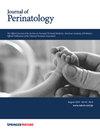新生儿先天性膈疝的术前生理性处理策略实施后的临床效果。
IF 2.4
3区 医学
Q2 OBSTETRICS & GYNECOLOGY
引用次数: 0
摘要
目的:评价基于生理性胎生过渡的先天性膈疝(CDH)新术前管理指南实施后的新生儿结局。研究设计:对新生儿CDH进行回顾性单中心研究。数据来自新指南实施前治疗的48名婴儿(Epoch 1)和实施后治疗的13名患者(Epoch 2)。我们假设在指南实施后,体外生命支持(ECLS)和吸入一氧化氮(iNO)的使用率会下降。结果:第2 Epoch的新生儿对ECLS和iNO的需求较低(p = 0.009)。结论:实施生理驱动的管理指南可降低ECLS插管率、呼吸机天数和iNO使用率。本研究证明了术前生理管理对改善CDH患者短期预后的影响。本文章由计算机程序翻译,如有差异,请以英文原文为准。

Clinical outcomes after implementation of a physiologic pre-operative management strategy in neonates with congenital diaphragmatic hernia
To evaluate neonatal outcomes in congenital diaphragmatic hernia (CDH) after implementation of new preoperative management guidelines based on physiologic fetal-to-neonatal transition. A retrospective single-center study of neonates with CDH was performed. Data were collected from 48 infants treated prior to new guideline implementation (Epoch 1) and 13 patients treated after implementation (Epoch 2). We hypothesized that rates of extracorporeal life support (ECLS) and inhaled nitric oxide (iNO) utilization would decrease after guideline implementation. Neonates from Epoch 2 had a lower need for ECLS (p = 0.009) and iNO (p < 0.001) compared to Epoch 1. Compared to Epoch 1, neonates in Epoch 2 had decreased invasive mechanical ventilation duration (p = 0.001). Implementation of physiologically driven management guidelines led to reduced rates of ECLS cannulation, ventilator days, and iNO utilization. This study demonstrates the impact of pre-operative physiologic management in improving short-term outcomes of CDH patients.
求助全文
通过发布文献求助,成功后即可免费获取论文全文。
去求助
来源期刊

Journal of Perinatology
医学-妇产科学
CiteScore
5.40
自引率
6.90%
发文量
284
审稿时长
3-8 weeks
期刊介绍:
The Journal of Perinatology provides members of the perinatal/neonatal healthcare team with original information pertinent to improving maternal/fetal and neonatal care. We publish peer-reviewed clinical research articles, state-of-the art reviews, comments, quality improvement reports, and letters to the editor. Articles published in the Journal of Perinatology embrace the full scope of the specialty, including clinical, professional, political, administrative and educational aspects. The Journal also explores legal and ethical issues, neonatal technology and product development.
The Journal’s audience includes all those that participate in perinatal/neonatal care, including, but not limited to neonatologists, perinatologists, perinatal epidemiologists, pediatricians and pediatric subspecialists, surgeons, neonatal and perinatal nurses, respiratory therapists, pharmacists, social workers, dieticians, speech and hearing experts, other allied health professionals, as well as subspecialists who participate in patient care including radiologists, laboratory medicine and pathologists.
 求助内容:
求助内容: 应助结果提醒方式:
应助结果提醒方式:


